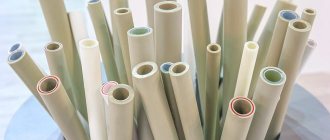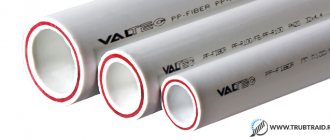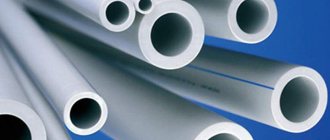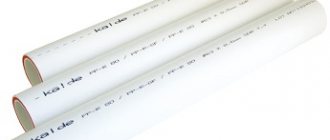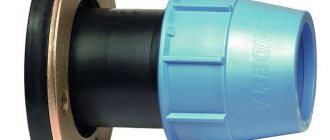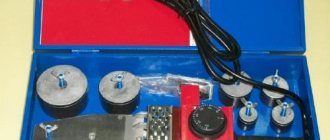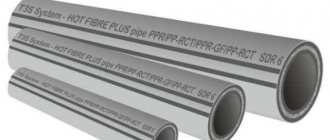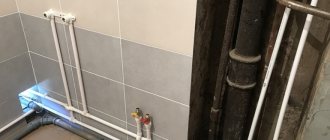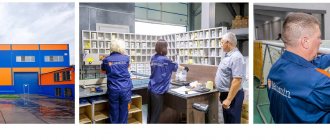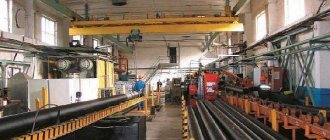Polypropylene (PPR) pipes are most widely used in the installation of water pipelines (drinking and technical) and heating. The advantages of PPR pipelines are resistance to corrosion and sedimentation, low heat loss, ease of installation and lightness of construction, and a relatively low price.
However, there is one obvious drawback. When exposed to heat, polypropylene expands, and the linear expansion can reach 10%. That is, each meter of pipe can increase by 10 cm if hot water is run through it.
In the case of an open pipeline, this will spoil the appearance of the room, as the pipes will bend in arcs or go in waves. If the pipeline is laid under finishing materials, there are 2 possible outcomes:
- when laid shallow, the expanded pipes will put pressure on the finish, which will lead to cracks on it or complete destruction;
- if the pipes are deep in the wall and have nowhere to expand, very strong internal pressure is built up in the product, and in the end it will simply burst, with all the ensuing consequences.
For this reason, ordinary polypropylene pipes are used only for cold water supply. The use of PPR pipes is also permissible when installing heated floors (up to +45 °C).
However, all other characteristics of polypropylene are so good that manufacturers decided not to abandon this technology, but developed a way to restrain linear expansion. Using reinforcement.
What are polypropylene pipes
Polypropylene pipes are characterized by high durability, resistance to elevated temperatures and chemical attack. In these positions, these products compare favorably with similar products made from other materials, especially metal. Since they do not rust, there is no corrosive coating on their surface. Also, polypropylene pipes are not afraid of rotting, exposure to bacteria and dirt, which gives them all the advantages when organizing pipelines for drinking water. The absence of limescale allows you to not be afraid of a gradual reduction in cross-section, and, as a result, a decrease in their throughput.
When comparing polypropylene and conventional plastic pipes, we can come to the conclusion that they are characterized by a significantly lower coefficient of thermal expansion (1 cm/1 m versus 10 cm/1 m, with an increase in temperature of 70 degrees). In winter, ordinary pipes can sag, and this looks rather unsightly. After installation, a brand new plastic heating system is very attractive, but when winter sets in, the situation changes dramatically, which negatively affects the overall appearance of the interior. An aluminum-reinforced pipe does not have such a drawback, which makes it possible to maintain the appearance of the system unchanged all year round, regardless of temperature changes.
Manufacturers of polypropylene pipes abroad and in Russia
Many companies in different countries of the world are engaged in the production of polypropylene pipes with aluminum reinforcement, so making a rational choice when purchasing is very difficult. If you look for reviews of installers on forums on the Internet, you can make a rating of the popularity of these products.
- Topping the list of manufacturers of polypropylene pipes are the German companies Banninger and Aquatherm - the best manufacturers . They are followed by Wefatherm and Rehau . German pipes of the Stabi are considered to be the highest quality products, and therefore their cost is the highest. These products can withstand temperatures of +130°C and pressures of up to 20 bar.
- Second place is occupied by products from Czech companies WAVIN EKOPLASTIK and FV-Plast . Reviews about their quality are no less enthusiastic, but they are still inferior to German ones.
- In third place are Turkish companies TEBO , Vesbo , Pilsa , Valtek , Kalde , FIRAT and Jakko . They produce their products using German technology, but the quality is inferior to German. Thus, when operating them, it is not recommended to raise the coolant temperature above +95°C - their thermal stability is lower than that of German ones. Sometimes the cross-section of pipes from Pilsa and FIRAT companies are oval, which is why their cleaning has to be repeated. The prices for these products are correspondingly lower.
- The fourth place is occupied by Chinese manufacturers BLUE OCEAN and Dyzain . BLUE OCEAN products are of fairly high quality, although the outer diameter may vary slightly even within the same batch. The inaccuracy of external markings is also noted. Dyzain products are not inferior to European ones in quality, but are much cheaper, thanks to which they are successfully sold on the Russian market.
- Fifth place in popularity among Russian manufacturers RVK , PRO AQUA , Santrade , Heisskraft and Politek . PRO AQUA products are 1.6 times stronger than similar Chinese ones, withstanding pressure up to 79.5 bar, which is why they are considered high-quality products. RVC products are given a low rating due to dimensional instability. Heisskraft pipes produced using German technology in the Moscow region are considered good products, although their cost is much lower than German ones. The quality of Politek's products is rated as "average", while Santrade's products are still little known.
Russian production of reinforced pipes is just beginning to develop. In the coming years, domestic products should take their rightful place in the Russian and world markets.
Kinds
Polypropylene pipes are usually divided into 4 types:
- PN10. With their help, you can only organize cold water supply. Operation with hot water is strictly prohibited.
- PN 20. Used in both cold and hot water supply systems.
- PN 20, glass fiber reinforced. They are used mainly for hot water, although they can also supply cold water.
- PN 25. Aluminum-reinforced polypropylene pipes: perfect for heating. Can also be used in cold water.
The positive qualities of polypropylene products give them the opportunity to be part of plumbing, heating and industrial systems. If we compare these products with metal ones, they are noticeably superior in terms of thermal expansion and oxygen permeability. This problem can be easily solved by reinforcement with aluminum foil.
Properties and characteristics of aluminum reinforced polypropylene
Fiberglass reinforced pipelines have a number of remarkable characteristics. One of the few disadvantages of such products is the permeability of the walls to molecular oxygen, which is one of the strongest natural oxidizing agents. This leads to accelerated corrosion of metal parts of pipelines:
- In heating systems, this is the inner surface of boilers, heated towel rails and metal heating radiators, as well as metal shut-off valves.
- In hot water supply systems, filters, metal-plastic adapter meters and everything that is susceptible to oxidation suffer.
The high protective properties of aluminum and its high metallic density are used here. Aluminum-reinforced polypropylene has the highest oxygen protection and can serve in plumbing systems for up to 50 years.
Polypropylene, labeled PPR , is a more durable material for hot water plumbing because it better withstands elevated temperatures and pressure in the system compared to other traditional products.
The inner surface of the pipes appears to be a stable surface, which:
- does not corrode;
- not subject to bacteriological contamination;
- does not deposit lime deposits typical of water pipes;
- practically not subject to physical wear.
This allows you to operate PPR pipes for a long time without changing the physical parameters of the system.
Purpose and methods of reinforcement of polypropylene pipes
The production of reinforced pipes has certain specifics. They are equipped with aluminum foil, the edges of which are usually fixed overlapping the pipes. As a rule, this technology is used by domestic manufacturers of polypropylene products. As for butt welding the edges of foil using a laser, this technology is also quite popular and involves a butt joint. If the foil is overlapped, it must first be cleaned before the welding procedure. This method allows you to avoid contact between the coolant and the foil: at the same time, the quality of welding of the fitting to the pipe does not decrease. In PEX/Al/PEX systems, the foil is usually butt-joined.
When the reinforcement of polypropylene pipes with aluminum was just beginning to develop, a continuous coating was tried. This did not allow oxygen to penetrate into the coolant, and the outside of the pipe turned out to be very smooth. The downside of this solution was the significant difficulty in connecting to the polypropylene layer. For this reason, it was necessary to observe special conditions of humidity and air temperature during the production process: the same applied to the quality of the glue used.
Disadvantages of PPR pipelines reinforced with aluminum
In this case, we are dealing with a fairly advanced material that can serve for a long time and reliably. However, it also has significant drawbacks.
These include the need to clean the joining ends and remove the reinforcing layer. This is an inconvenient operation, an error, the execution of which can lead to a violation of the integrity of the system.
Watch the video
Disadvantages also include the instability of the material to the effects of hard ultraviolet radiation. With prolonged exposure to sunlight, it becomes brittle and can easily break.
To enhance the ability to withstand ultraviolet radiation, soot is added to the composition in an amount of up to 2% of the total mass. But it’s safer to simply not use PP pipes for pipelines in open areas.
What is central reinforcement of polypropylene pipes
Polypropylene pipes, in which the reinforcement is overlapped, are characterized by one significant drawback, which makes their installation rather inconvenient (we are talking, first of all, about welding). The fact is that before starting welding, these products must be cleaned, that is, the top aluminum layer and the outer decorative polypropylene coating must be removed. To simplify this procedure, a number of manufacturers have mastered the use of central reinforcement.
In this case, the characteristics of an aluminum-reinforced polypropylene pipe are preserved - a low coefficient of linear expansion and low permeability to oxygen. That is, the linear expansion of polypropylene pipes will be quite acceptable. The only point is that you have to spend some time on trimming, which makes it possible to create a reliable barrier between the foil and the coolant.
If this procedure is neglected, this can lead to penetration of moisture from the pipe into the gap between the polypropylene and the foil: as a result, the surface begins to swell. Because of this, damage to the pipeline occurs: the reason lies in the very small thickness of the decorative polypropylene layer, which is characterized by low strength - it is definitely not capable of loads of this level. The destruction of this layer is usually just a matter of time, after which the coolant begins to leak, with all the resulting consequences.
With this danger in mind, trimming before starting installation work becomes a mandatory procedure when it comes to centrally reinforced pipes. However, there is such a nuance that it is not possible to check its quality if it is a finished assembled pipeline. In this case, all hope is that the master plumbers turned out to be decent people and did everything professionally. However, it also happens that professionals make the mistake of following the advice of some suppliers to skip pre-stripping. You can achieve good quality welding work without preliminary trimming using special attachments.
Comparison of fiberglass and aluminum reinforcement methods
Reinforcement of polypropylene is done by adding a layer of fiberglass or aluminum foil.
Typically, the “reinforced” material has the form of a sandwich:
- Inner PPR layer,
- Reinforcement,
- Outer PPR layer.
In the case of aluminum reinforcement, it is possible that the pipe consists of only 2 layers. Then the aluminum foil appears on the outside and not only adds rigidity to the material, but also becomes protection from UV rays.
Regardless of the method of PPR reinforcement, pipes with a rigid frame greatly benefit from unreinforced products. Most of the characteristics of fiberglass and aluminum foil pipes are the same, but there are still differences that can affect the choice of product.
| Fiberglass | Aluminum | |
| Anti-corrosion properties | + | + |
| Inertness towards transported media | + | + |
| Smooth inner surface and no risk of sediment settling | + | + |
| UV resistance | — | only if the aluminum layer is the outer layer |
| Resistance to hot environments (up to +100 °C) | + | + |
| Thermal conductivity | slightly lower than aluminum | slightly higher than fiberglass |
| Nominal pressure | up to 2.5 MPa | up to 2.5 MPa |
| Linear expansion coefficient | up to 1% | up to 1% |
| Strength and resistance to mechanical damage | lower than aluminum | higher than fiberglass |
| Small outer diameter | with equal internal diameters, the outer diameter is larger, since the fiberglass layer is thicker than the aluminum foil layer | + |
| Light weight of the finished structure | + | + |
| Ease and convenience of installation | + | require additional cleaning before installation |
| Price | higher than aluminum | lower than fiberglass |
We recommend that you read: Polypropylene pipes and their sizes: how parameters affect the operation of the system
How aluminum-reinforced pipes are terminated
The procedure for installing cold and hot water supply systems, as well as a heating system, with reinforced polypropylene products has significant similarities. Strictly speaking, anyone who has experience working with one of the systems has every chance of installing another system.
List of required operations:
- Cut parts according to the dimensions specified in the planning documentation.
- Perform chamfering.
- Heat the communication and fitting using a special heating pad.
- Combine welding.
As for the most significant differences, we are talking about the above-described procedure for stripping the ends: it is carried out in cases where reinforced aluminum products are used. Before you start heating the system and its connections, you need to remove the aluminum layer from them. This operation is carried out using a special coupling equipped with cutters: the pipe is inserted inside the device, and after a couple of turns it is ready for welding.
To prepare pipes with central reinforcement, you will need a more complex tool called a “cutter”. It makes it possible to quickly free the end of the pipe from the inner layer of aluminum. Thanks to this, an increase in the reliability of the connection with fittings by welding is achieved. In this case, the product does not delaminate, and the aluminum layer is not destroyed. Polypropylene reinforced heating pipes are the best option for installing modern heating systems. They are much easier and faster to install, and proven manufacturing technologies allow them to be at least as good as traditional metal products.
Why is reinforcement needed?
Currently, most polypropylene pipes are made from high-strength PPR (PP-R, PPRC) material. It has improved properties that allow products to withstand increased loads. However, even in this case, polypropylene remains subject to its main disadvantage - linear expansion as a result of thermal effects.
The fact is that when constantly working with highly heated (up to +95°C) working environments, polypropylene pipes receive a large amount of heat. In this case, the material tends to deform from severe overheating. As a result, it turns out that each meter of laid pipes lengthens on average by 8 mm (the exact figure depends on the design of the product, temperature stability and other factors). Accordingly, if there is an extended straight section of communications 3 meters long, then, provided the temperature is consistently high, the pipes will lengthen by 2.5 cm.
This phenomenon leads to the fact that the laid networks begin to deform and sag, as a result of which the loads are unevenly distributed and the appearance of the structures is distorted. And in the future, such a situation may even lead to an emergency and a complete stop of the pipeline. Therefore, for the installation of critical systems operating at high temperatures, aluminum-reinforced PPRC polypropylene pipes are used.
These products are multilayer products: between the top and bottom layers of polypropylene there is aluminum foil, which is attached using special adhesive layers. As a result, a reinforcing layer is located right in the center of the pipe, significantly reducing the coefficient of thermal expansion. In digital terms, the indicator decreases several times: from 10 mm to 2.2 mm for each meter of pipes, subject to heating from +20°C to +95°C. As a result, the same structure, 3 meters long, is lengthened by only 0.7 cm.
Thus, polypropylene reinforced with aluminum is much more reliable, durable and wear-resistant. Therefore, such pipes can be safely used for arranging heating systems, hot water supply or transporting media with a high degree of heating.
Buy polypropylene pipes reinforced with aluminum at low prices with delivery
The catalog of the online store PPRCSHOP.RU presents polypropylene pipes with aluminum reinforcement, which can be purchased in a wide range of sizes. For laying household communications, products with a nominal diameter of 20, 25 and 32 mm are most in demand, and for critical systems and industrial lines, pipes with a larger cross-section (from 40 mm) are usually purchased.
Detailed product characteristics and prices for aluminum-reinforced PP pipes are indicated in the product cards. To place an order, add the required items to your cart and confirm your purchase. When processing your application, the manager will contact you to clarify issues of payment and delivery. At the client’s request, we can coordinate prompt pickup of products from a warehouse in Moscow, delivery of the order by courier, or dispatch of goods by a transport company to any region of Russia.
For detailed advice, call the numbers listed in the contacts. We will be glad to see you among our company's clients!
FORA PP pipe reinforced with aluminum (inside), PN20 (SDR6)
Manufacturer: FORA Series: Polypropylene pipes
Price from 111.15₽ per meter
| Vendor code: | Size | Price | Quantity | Sum |
| 026010602 | 20×3.4 | 111.15 | 111.15 | |
| 026010603 | 25×4.2 | 158.65 | 158.65 | |
| 026010604 | 32×5.4 | 262.57 | 262.57 | |
| 026010605 | 40×6.7 | 428.09 | 428.09 | |
| 026010606 | 50×8.4 | 642.70 | 642.70 | |
| 026010607 | 63×10.5 | 997.16 | 997.16 |
Description
